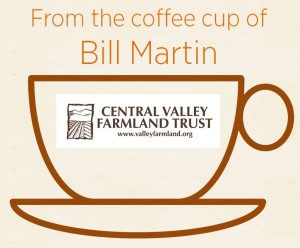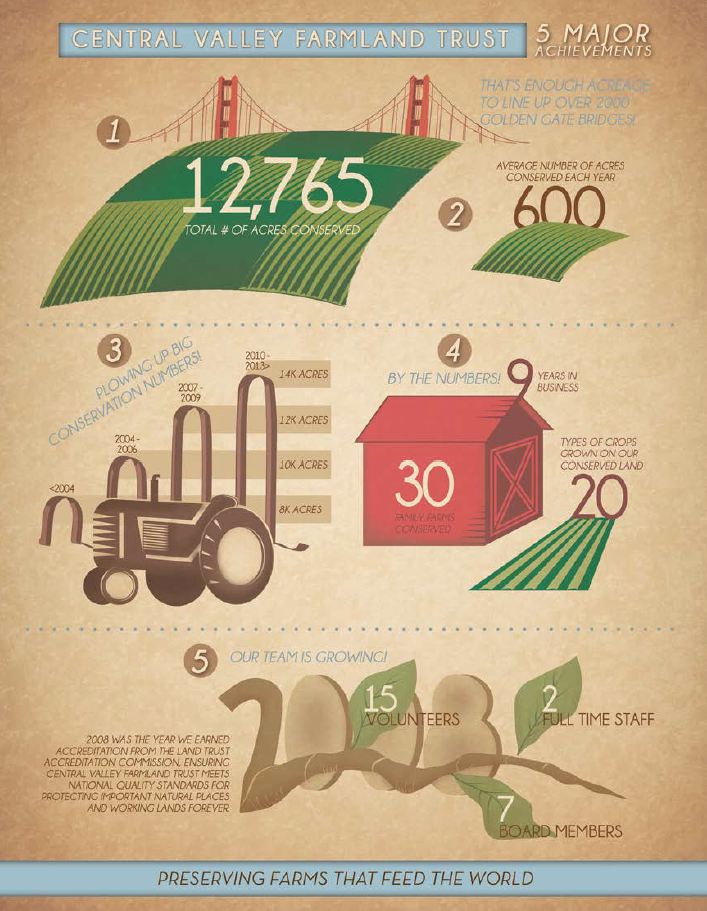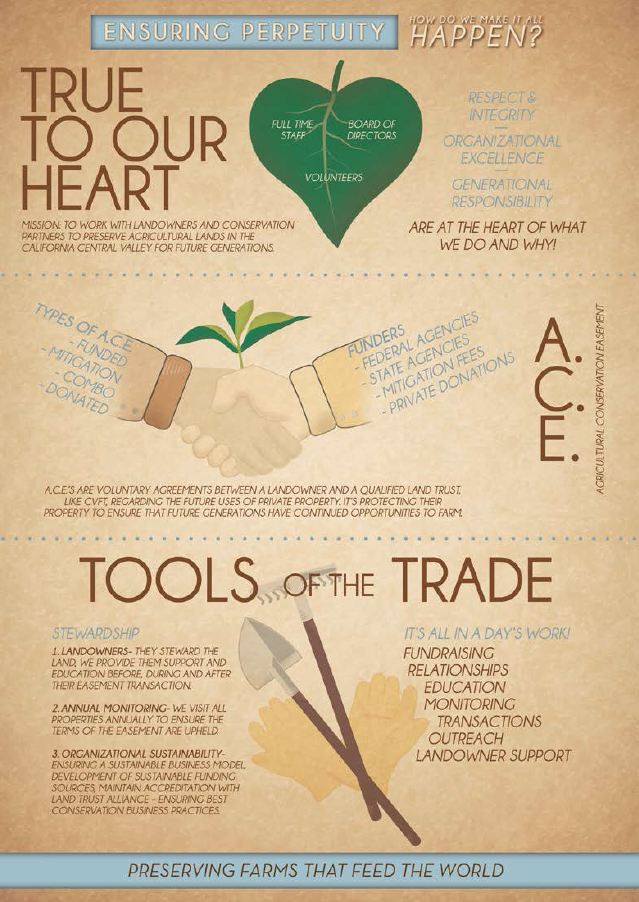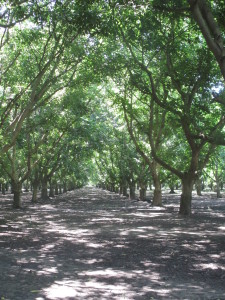 The Central Valley Farmland Trust (CVFT) is a non-profit public benefit entity (501 c(3)) engaged in the preservation of prime irrigated farmland in the Central San Joaquin Valley. We work to preserve local farmland mainly through the voluntary acquisition of agricultural conservation easements (ACE) from willing landowners. CVFT was formed in 2004 via the merger of three existing land trusts, currently operates in Merced, Stanislaus, San Joaquin and Sacramento Counties. The CVFt holds approximately 13,000 acres of ACEs.
The Central Valley Farmland Trust (CVFT) is a non-profit public benefit entity (501 c(3)) engaged in the preservation of prime irrigated farmland in the Central San Joaquin Valley. We work to preserve local farmland mainly through the voluntary acquisition of agricultural conservation easements (ACE) from willing landowners. CVFT was formed in 2004 via the merger of three existing land trusts, currently operates in Merced, Stanislaus, San Joaquin and Sacramento Counties. The CVFt holds approximately 13,000 acres of ACEs.
California leads the nation in agricultural production as our moderate climate, fertile soil and diverse land resources allows year-round production of many agriculture commodities. The state produces more than 400 crops. In California the majority of Prime Farmland is located in the San Joaquin Valley, which boasts of a combination highly productive soil, abundance of irrigation water, lengthy growing season, technology, and adaptive delivery systems. This agriculture region is not and cannot be duplicated anywhere else in the world. About 90 percent of The Golden State’s farms are family-owned. But this farmland is disappearing at an alarming rate. Unfortunately we lost 560,000 acres of Prime Farmland between 1984 and 2008. To put this in perspective it equates to 875 square miles of lost farmland. This loss can be attributed to a number of factors including urbanization, low density rural residences; mining and ecological restoration projects resulting in fewer jobs and lower tax revenue for counties and cities.
__________________________________________________________________________________
The mission of the Central Valley Farmland Trust is to work with landowners and conservation partners to preserve agricultural lands in the California Central Valley for future generations.
__________________________________________________________________________________
Agriculture Conservation Easement 101
There are many misconceptions about conservation easements. In this article we will attempt to clear up some of them. The IRS Code, Section 170(h)(4) has identified four purposes for conservation, and they are as follows:
- Protection of a relatively natural habitat of fish, wildlife or plants, or similar ecosystems;
- Preservation of land areas for public outdoor recreation or education;
- Preservation of open space, including farms, ranches or forests, for the scenic enjoyment of the general public, or pursuant to governmental policy;
- Preservation of a historically important land area or certified historic structures.
It is the mission of the Central Valley Farmland Trust is to work with landowners and conservation partners to preserve agricultural lands in the Central Valley for future generations. There are many other land trusts that work to conserve the other types of lands listed above, but our focus is strictly farmland and the easements we hold are referred to as agricultural conservation easements (ACE). An ACE is generally the least restrictive of all conservation easements.
__________________________________________________________________________________
An Agricultural Conservation Easement (ACE) is a legally enforceable land preservation agreement between a landowner and a qualified land protection organization for the purposes of conserving productive farmland.
__________________________________________________________________________________
 A conservation easement is an effective way for landowners to preserve their land. The decision to place an ACE on a property is completely voluntary. However, once an easement is in place, it remains in perpetuity. The land may be sold or transferred to heirs via a will or a trust, but the easement and respective restrictions remain in place. Land that has an ACE is protected by prohibiting the conversion of that land to non agricultural uses. The terms of the easement do not negate or modify local, state, or federal law and a conservation easement cannot prevent condemnation.
A conservation easement is an effective way for landowners to preserve their land. The decision to place an ACE on a property is completely voluntary. However, once an easement is in place, it remains in perpetuity. The land may be sold or transferred to heirs via a will or a trust, but the easement and respective restrictions remain in place. Land that has an ACE is protected by prohibiting the conversion of that land to non agricultural uses. The terms of the easement do not negate or modify local, state, or federal law and a conservation easement cannot prevent condemnation.
No two conservation easements are alike. Each is tailored to the desires of the landowner(s), the interests of the land trust and the unique character of the land. As mentioned above the landowner retains the use of the land and can sell, lease, or pass on to his/her heirs. CVFT is not involved in the day-to-day operation. Unless specifically provided within the ACE document, there is no government intervention on land subject to an ACE (Note: This only occurs when a government agency has provided ACE acquisition funding and then only in the event the holder of the ACE is not meeting its obligation to protect the ACE). Nor does the public have the right to trespass on the property. Continued ranching and or farming by the landowner is encouraged and some limited development may be allowed. New farm buildings and future home sites are commonly included in the easement terms.
There may be tax benefits to the landowner who places a conservation easement on his/her property. To qualify for an income tax deduction, the easement must meet the conservation purposes included in IRS Code, Section 170(h)(4) (see above). To qualify as a charitable gift, conservation easement must be granted in perpetuity to a qualified conservation organization. It may reduce income, estate and gift taxes.
CVFT strongly recommends that the landowner consult with a tax advisor and independent legal council before proceeding with an ACE.
ACE Selection Criteria
- Soils: Farmland evaluated by the California Department of Conservation Farmland Mapping and Monitoring Program as being “Prime farmland” or “Farmland of Statewide Significance” will receive the highest priority. The Central Valley Farmland Trust might also consider farmland designated as property that has significant value to the regional agricultural industry regardless of soil characteristics.
- Water: The property has a dependable and sustainable supply of high quality water for irrigation.
- Agricultural viability: The land is large enough to sustain commercial agricultural production. The property is not substantially surrounded by urban development such that its continued agricultural viability is threatened.
- Urbanization pressure: The property may be subject to urbanization pressure within the foreseeable future.
- Consistency with community plans and goals: Existing community goals, plans, and political boundaries are compatible with permanent agricultural use of the property. The property is currently zoned for agriculture. The property is outside the primary sphere of influence of a city or a community service district. An agricultural easement on the property would have the
potential to have a long term impact on urban growth in the area and encourage growth on less productive farmland.

Valuing ACEs
This is accomplished by a qualified appraiser and is completed by way of a two step process (e.g., Before & After values). The ultimate value depends on a myriad variable factors, but in essence is the difference between the current fair market value (“Before”) and the restricted value (e.g., as though the property has already been restricted by the ACE) (“After”). Some of the variables include size, location, number of legal parcels, level of threat to productive agriculture, etc. It is typical to see the indicated ACE values ranging from 30% – 40% of the open ground fair market value.
Funding ACEs
This is probably the most challenging issue CVFT faces on an ongoing basis, given the scarcity of sources through which funding occurs. Historically CVFT has relied on the California Department of Conservation through its California Farmland Conservancy Program and the US Natural Resource Conservation Service via its Farm and Ranchland Protection Program. In certain jurisdictions CVFT also has availability of funds collected by government entities (e.g. Cities & Counties) as a result of farmland mitigation programs in place in those areas. These funds have been used in conjunction with other funding sources to leverage overall funding.
Grower Bio: Galeazzi Farm Forever Conserved
Under the cool canopy of a grove of mature walnut trees, one can visualize the past and future generations of farmers and families playing and tending to these trees, their branches heavy with bounty. This picture is no truer than on the 250-acre walnut farm owned by the Galeazzi family located near Lockeford, recently conserved with an agricultural conservation easement between the family and Central Valley Farmland Trust.
“This property is a beautiful example of farming, family, conservation, and a legacy realized,” said Bill Martin, executive director for Central Valley Farmland Trust. “We are proud to see this farm protected for future generations and know that the Galeazzi family will remain there as stewards of the land.”

It’s All in the Family: Farm owners, John Galeazzi and his wife of 50 years, Carolyn, have been farming all their lives. John’s family emigrated from Italy to the United States in 1894, settling in Modesto where they began farming a variety of crops. John and Carolyn followed suit and raised their three children on the farm. Their son Tom, and his wife Tawnya, are part owners in the family farm today, and two daughters, Lisa and Julia, are involved as well. Julia and her husband, John Vink, also farm adjacent to the family property.
There are two grandchildren to carry on the legacy to date – Bella, “four and a half” as she says, and little 16-month-old Johnny. “This conservation easement preserves our life-long dedication to farming,” said John Galeazzi. “All my children could see the connection between farming and conservation and we wanted to integrate the conservation part into our business. This easement allowed us to do that.”
“Our future is more certain – we know what we will be doing and we can work toward the best management with that knowledge,” continued Tom Galeazzi.
The Operation: On the Galeazzi Farm they focus on efficient and economic practices for managing and harvesting their walnuts. They do a multiple shake on the trees and several sweeps to capture nuts and reduce litter on the ground that could become a management challenge later in the year. From soil amending in November after harvest is done, to pruning, grinding brush, managing for pests, and then leaf analysis in June and July, it’s all for August when the nut sizes and the kernel fills.
They begin harvest in late September when they are hauling up to five truck loads at a time. The nuts are hauled to local processors that contract with local and overseas buyers. “The farm is nearly all in walnuts,” said John. “We do our complete harvest and trucking – we are proud of our full-time staff and a return crew for pruning each year. Worker safety is taken very seriously and is of the utmost importance to us. Our staff is like our family too.”
The Resources are Right: Lockeford is in the heart of a prime walnut growing region in California. “The climate, our deep fertile soils, and water make this nearly the best place on earth to grow them,” said John. In addition to the perfect environment, the Galeazzi’s have other vital resources at their fingertips. Their farm advisor and relationships with UC Davis personnel keep farm management on the cutting edge and improve production practices. The easement also preserves the family’s water rights along the river adjacent to the property.
Farming, while not in a building, is a business and must be run in a fashion to sustain itself. But in a business where the land cost is so high protecting what you have could be essential, John Vink said, “This conservation easement offers us security for the family at large, we have built a nice economic block of property with resources that will serve us well into the future.”
A Legacy: While grandkids kiss and love their grandpa who has ensured their future, you can see the pride in his eyes as he takes his family in. “This property carries economic value and peace of mind for our family, our workers, and our future,” said John. His wife echoed his sentiments saying, “We are very happy to know this property will be in our grandchildren’s hands.”
“We are lucky enough to work every day to ensure families like the Galeazzi’s stay on the land producing food close to home,” said Bill Martin. “Their legacy becomes everyone’s legacy when our precious farmlands become a permanent part of the future of California.”

